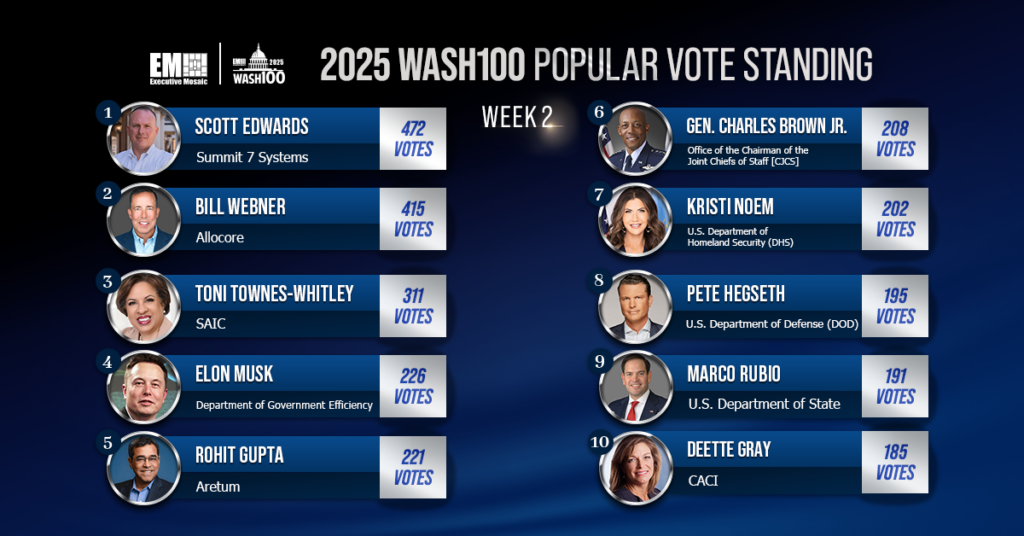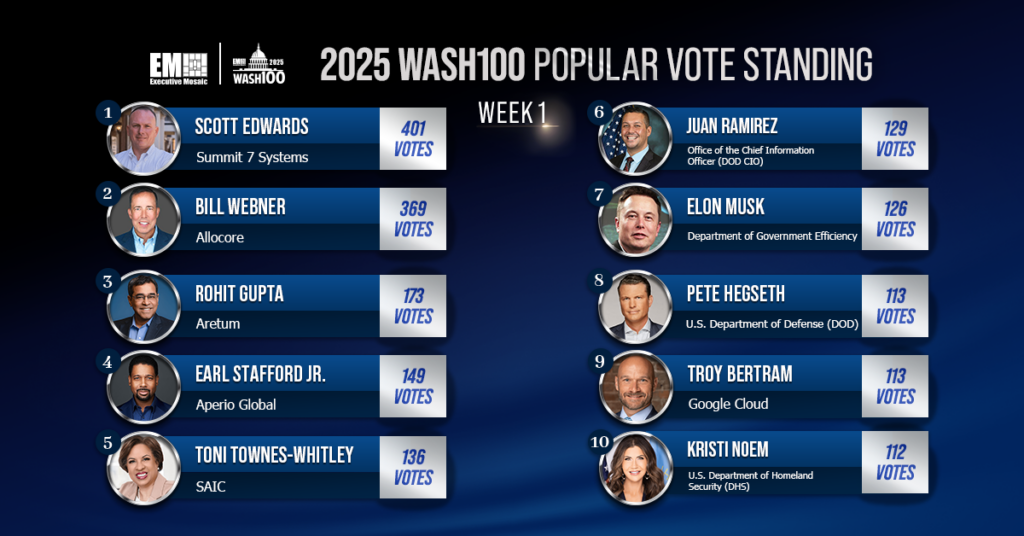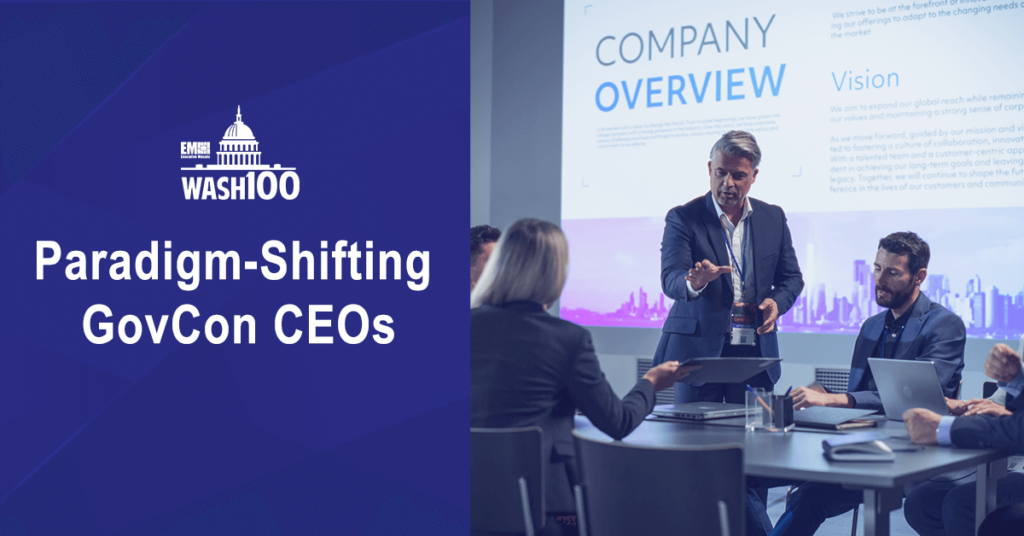Greg Wenzel, an executive vice president with Booz Allen Hamilton and a two-time Wash100 Award recipient, spoke with ExecutiveBiz for the publication’s latest Executive Spotlight interview discussing the positive results of Booz Allen's second quarter and new market opportunities for its customers as well as the long term success of JADC2, the impact of emerging technologies on training modernization and more.
“We know the mission at hand and we’re focused on getting the DOD in this space and providing our soldiers, airmen and women what they need to survive and thrive in a near peer environment. We’re proud of the job we’ve done and the work we have towards our mission.”
You can read the full Executive Spotlight interview with Greg Wenzel below:
ExecutiveBiz: Congrats on the recent results of Booz Allen’s second quarter. What can you tell us about the company’s goals moving forward through its VLT strategy to continue driving growth in the federal space and new market opportunities for your customers?
“First and foremost, Booz Allen is a software company. We have a great history and heritage of being a consulting company, but we've been through this journey of transforming. We recognized our innovation spirit back in 2012, and our current CEO has the next generation of our vision through velocity, leadership and technology (VLT).
In a nutshell, that’s our moniker as we move forward and continue on our innovation journey to support our clients. We’re also adding even more solutions to our portfolio. We are becoming a software company and we’re building mission critical systems for a lot of our federal clients.
We're looking at where we’re going in terms of new areas that also work as mission-based solutions and platforms to new business areas. We’re consolidating everything to operate around missionaries and providing solutions in national cybersecurity, which includes all things cyber and the future battlefield.
That’s where I’ll lead us to focus on networking and establishing a joint network digital warfighting force for the next hundred years. In order to increase our velocity and apply the technology we have, we’re bringing those areas that support decision making superiority.
It’s about taking pieces out of each of our former businesses and putting them into a new business to accelerate the increase of our velocity where we build a custom mission solution based on open government and our own open architecture platform. That’s what we consider to be our hallmark.
That’s a personal passion of mine. If you look at my career, I’ve been working Joint for at least two decades now. We’ve been in a coin fight for the last 20 years. With previous issues around counterinsurgency, we had access to whatever we wanted to prepare for the next fight, but we don’t have that kind of access anymore so we need to implement a different set of technologies.
I think the future of warfare is mostly going to be non-kinetic. It’ll be about information superiority and dominance. It’s classic Sun Tzu, ‘If you know yourself and your enemy, you need not fear any future battle.’ I think networking is going to be key, especially with our peers all having similar technology.”
ExecutiveBiz: Why does the DOD need an open and unified network in order to continue to drive tech capabilities for our warfighters in data access, sharing and other areas of battlefield intelligence? How will that united platform ensure the long term success of JADC2 as well?
“"We're really excited about the JADC2 concept that we started. I am the CTO for our Global Defense group. We met virtually at first and then about two years ago, we wanted to network across the Army, Navy, Air Force and we started to get all these people together to begin collaborating across these different teams.
Fast forward two years, you hear about JADC2 and we think we're prepared with a lot of ideas and solutions because it is an imperative concept to implement. I look at it like the culture of DOD in that their acquisition processes are designed to build platforms, aircrafts, tanks, ships, kinetic weapons, etc.
When it comes down to it, we create networks on networks on networks and there are a lot of reasons for that, such as classified information. However, if the Navy builds a radio and the Army builds a radio, but the radios don't talk to each other. A 'Joint Radio System' isn't going to work very well.
I think that's a significant challenge for DOD. It's about the private sector who's doing it really well. The way they operate is the digital ecosystem. It is more smaller things modular components network together to create a new solution rather than building an aircraft.
“We’re hoping to continue working with DOD to help them decompose their mission areas into smaller and similar pieces. A couple years back, we had an investment that we called ‘digital battlespace connect,’ which was a way to create a smart data fabric that would allow you to connect and get data from the enterprise to the very tactical edge. In terms of low bandwidth, I’m talking about less than a mobile phone.
The Army Futures Command (AFC) that also created the ‘Rainmaker’ program that was demonstrated in Project Convergence. It’s that type of data fabric that connects joint strike fighter data all the way to a kinetic effect. That’s what we’re focusing on as we continue to partner with the Army and other services. It’s really exciting and could well be the precursor to JADC2 data fabric.
When people think we can solve the technical data fabric issues, they don’t seem to understand what the problem actually is at hand. We basically assembled COTS and open source into an end to end enterprise solution.
In the future, a data fabric is an assembly of several pieces versus having one single solution that can solve it all. That’s what we’re seeing with JADC2 and federal agency missions ascending across acquisition boundaries and multiple organizations.
You can’t just buy something. You have to build up the components and have a digital integrator that stitches them all together. That gives the government flexibility to make sure they're not locked in and they're not beholden to one vendor.”
ExecutiveBiz: With emerging technology such as augmented reality, virtual reality and others, what are your thoughts on the future of tech and training modernization to keep our warfighters and military systems ahead of the curve as technology continues to leap forward so rapidly?
“In the digital battlespace, the lines are blurring between organized missions that transcend acquisition and organizational boundaries. The line between training mission rehearsal and mission executive is starting to collapse because the technology is evolving. You mentioned VR technology and I’ve been playing with virtual reality with silicon graphics back in the 1990’s.
In the modern day, the refresh rate and networking has improved so greatly that we can fight the fight ten times over before ever putting boots on the ground, which reduces the fog of war.
We are closing the boundaries from training in a remote location to simulating real environments so you’ve been there before and it’s not new to be dropped into a neutral location. We’re working on training and mission rehearsal. We're measuring the effectiveness of those training in simulation products and how they assist the soldier in mission execution.
The question is how do we know that our training process is effectively teaching our warfighters what they need to be successful when it’s for real.
How fast can you clear a room? Were there casualties? What was the stress level of the soldier in the room? If you’ve trained for that specific room through VR or augmented reality, it’s going to be easier because you’ve been there before and you’ll recognize when something is different.
We’re experimenting with something called XRay, which is our extended reality augmented engine analytics engine that actually measures the performance of the AR/VR technologies on the soldiers and training. We're using these advanced technologies to add more training solutions. At the end of the day, we’re working to make the warfighter more effective and lethal.”
Booz Allen is focusing on these mission based solutions. We’re trying to experiment in the national cyber and digital battlespace. I'm leading our digital space networking. We take an open architecture approach first that is truly open where we don't own the API. The government owns AIs and then we get the best of industry and open source to plug in. That's what we call the new digital integrator.
We know the mission at hand and we’re focused on getting the DOD in this space and providing our soldiers, airmen and women what they need to survive and thrive in a near peer environment. We’re proud of the job we’ve done and the work we have towards our mission.”





